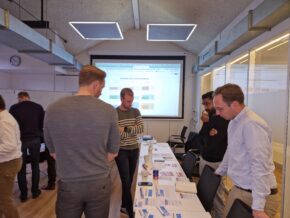Hollywood Dreams – SIAM
Do you recognize this?
Cooperation between business and IT suppliers does not happen by itself. It requires direction! The governance of outsourcing is a high-priority agenda item for organisations. Service Integration and Management (SIAM) involves integrating the sub-services of all kinds of internally outsourced services (including shared services) and externally outsourced services (including cloud services) into an IT chain that increases the efficiency of business processes and helps realise business goals.
In this simulation, you will experience what it means to run an IT service with the support of multiple suppliers. You will experience the following items:
-
How can you build the bridge between the business (demand) and underlying service providers (supply) in order to deliver the value that the business needs?
-
How can you ensure that suppliers make the best possible contribution to the business?
-
How do you ensure the right choices and priorities?
-
How do you analyse, improve and adjust the contracts when the demand changes?
Hollywood Dreams gives you a real-life experience of this and prepares you for the existing challenges in your organisation.
About the “Hollywood Dreams” simulation game

Hollywood Dreams produces several movies each month and sells movie tickets at the cinema. Hollywood Dreams faces an enormous challenge to improve sales and profit. It therefore outsourced IT services to three suppliers and expects these IT suppliers to automate and innovate to support its growth strategy.
You will be working as business managers, contract manager, integration manager, service manager or one of the 3 suppliers to make Hollywood Dream reach its goals.
Hollywood Dreams innovates its services, and in this simulation the business managers will bring in new ideas to increase sales and reduce costs. However, without effective collaboration with the suppliers this will be a challenge.

Later in the year Hollywood Dreams must be ready to launch the new James Bond movie. At this moment the organisation is not ready for such a huge program. But, hopefully there is enough time to prepare the suppliers and the own business processes.
Can the business work with the suppliers and take advantage of the upcoming blockbuster
You experience Hollywood Dreams optimally in one day with (one or multiple) teams of 8 – 12 people. While playing, there is enough time to reflect on one’s own work situation, thereby learning for current and future challenges.
Hollywood Dreams makes your employees better equipped to govern, manage and integrate services.
Set up of the Simulation
By playing in a number of game rounds and reflecting and improving between rounds you will also need to apply ‘continual learning and improving’ as a core team capability.
The simulation consists of 4 rounds. In each round, the team will experience one or more aspects of Service Integration and Management. Each round starts with preparation time in order to improve processes. Vendors can buy extra resources and the Contract Manager discusses the contracts and agreements with the suppliers. Fees need to be paid. Then the Business will share and prioritise the projects with the Integration Manager and the suppliers can start to plan applications, RFCs and innovations. In the meanwhile, incidents will be reported at the vendors of IT Support and IT Operations
Target audience
Hollywood Dreams Simulation is qualified for all managers and their employees involved in outsourcing, directing and integrating digital services.

-
Employees of IT (Operations) teams
-
IT managers and team leaders
-
Development teams
-
Business roles
-
Contract Managers
-
Service Integration Managers
-
SIAM specialists
-
Students having followed SIAM training can experiment with translating SIAM theory into practice
Details about this simulation
| Duration of the simulation: | 1 day |
| Number of participants: | 8 – 12 |
| Basic expertise: | No basic understanding required. |
